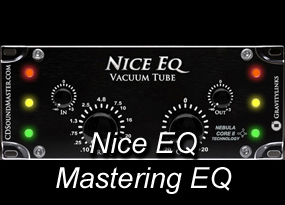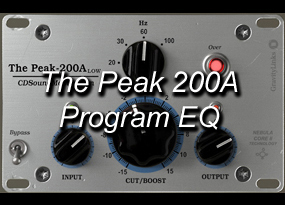Audio Recording with Equalizers 5 Types of Equalizers Part Three: The Mastering Equalizer
Mastering has become one of the most misunderstood and complex aspects of music production. It is primarily about simplifying everything that has come before this stage, but because it is a skill that has such crucial consequences, it is a profession and skill that is set apart from recording and mixing in many ways. Therefore, this description of what makes a great Mastering EQ, I will first give a brief overview of Mastering as a process.
When dealing with recording, we might be concerned with elements like learning the different types of microphones that there are and when to use them, what the best preamps are, how to tune instruments, how to set your levels for recording and for headphone balance. If we were looking at the elements involved in the mixing process, we might talk about the purpose of the sections of the analog mixing console, clarifying the definition of a DAW and how to use it. We might cover how to set levels and bus groups and how to effectively use channel EQ’s the best way.
With Mastering, the first thing that we should assume is that the Recording and Mixing stages of the process are complete. Once everyone is happy with how the recording process has gone, they can work towards getting a proper balance of tracks, adding whatever effects and fine-tuning may be involved in providing the final result they envisioned, hopefully even exceeding their expectations. Once this final mixdown process is complete, the recording will normally be a stereo Master, or Pre-Master, depending on who you ask and what stages are expected. Now, we enter the Mastering stage of the process.
In Mastering, there is nothing that can improve upon an absolute perfect Mastering Session. In my opinion, the ideal, absolute perfect Mastering Session involves a single listen through, under ideal conditions, of the entire Program Material, at which point there is quite literally nothing that the Mastering Engineer thinks should change, other than the spacing and ordering of song tracks, and any personalization of track information like tracking codes, artist and writer and label information, etc. In an absolutely perfect world, the best Mastering Session would last about an hour longer than a listen through of the album, and nothing would change. This would re-enforce the artistic and engineering decisions made from recording to mixing down, with everyone having done such a remarkable job, even down to tuning their instruments, that there is nothing to change or enhance; not even the balance of levels from one song to the next. In this amazing, and almost non-existent imaginary event, it truly does not matter what equipment the Mastering Engineer owns in regards to their EQ or other Outboard analog gear. The only elements crucial would be their brain, ears, room qualities, position, speakers, amplifiers, and cables. The ability to listen, concentrate, and process what is heard would be the elements that matter the most.
As you may have already guessed, Mastering usually involves more than listening and inputting some relevant file data. Usually, the mere process of the mixing sessions alone are partly what leads to the need for a great Mastering Equalizer. In our “perfect world” scenario, the balance from one song to the next would have to come not just from good sounding, individual song mixes, but a balance that makes so much sense from one to the next, that these translate to a consistent perceived volume level throughout the entire project. This is not common in almost any group of songs that are born out of a studio recording environment. Even if every musician stood in exactly the same position for every song, and every microphone remained at the same distance, and every dial remained the same, and everyone was remarkable at maintaining a consistent performance and energy, and the range of musical material had a perfectly arranged flow from one song into the next, the likelihood that every element would be brought together with absolute perfection to such an extent that there was nothing to benefit from any further adjustments at the Mastering stage is unbelievably slim. This does occur every rare once in a while, but inevitably there are going to be some tracks on an album that hold the other performances or mixes to a higher standard, and this alone can leave the Mastering Engineer some work to do their best to raise lesser tracks to the audio fidelity of the album’s best tracks.
No matter what the actual scenario involves, there are certain qualities that a Mastering Engineer requires from their Mastering EQ’s that are unique compared to any other EQ. Once again, there is always some overlap. Since the standards are very high when it comes to an ideal Mastering EQ, one can assume that a Mastering EQ is also going to perform amazingly well for Bus groups and Mix EQ challenges. In fact, it is nearly impossible for a great Mastering EQ to fail at other tasks, but not every Bus or Mix EQ is going to be perfect for Mastering.
The Mastering EQ is going to be a stereo EQ or a well-matched and calibrated pair of Mono EQ’s. The quality of the EQ needs to be capable of maintaining the integrity of the original recording without removing any volume, timing, phase, stereo imaging, noise, or headroom. It will favor clarity over musicality or positive coloration in character, but the perfect Mastering EQ has the ability to add a very subtle musicality even while remaining incredibly clean. Typically, we might be looking to add something with character at earlier stages in recording, making an artistic statement in the writing of the music itself and in translating it to a working mix. A recording may be slow and fluid, or sharp, fast, and articulate. The sound maybe rich and ambient, or may change pace and instrumentation. These musical qualities may nod towards different Mastering EQ’s. Some Mastering EQ’s are designed for precise response by minimizing the amount of electronics in the signal path and synchronizing how each Frequency is adjusted, where other Mastering EQ’s use extremely high quality electronics that add color, but in a precise manner that works well with sound adjustment. Transformers, Op-Amps, Tubes, Capacitors, and even wires and cables all add some measure of personality into the sound process, and high quality parts can remain clean and transparent enough for any audio task while allowing the user to decide which of these characteristics will make a good match for a song or album.
Mastering EQ’s need to have enough variation to work on a wide range of tasks, but vary in their approach. With Program Equalizers like Pultecs, there are several separate bands that each perform a task, focusing mostly on fixed Frequencies and broad strokes, with some adjustment of actual “Q” widths. Other EQ’s like the Sontec, GML, and Millennia Mastering EQ’s provide overlapping ranges of Frequencies with variable “Q” width, some with the ability to repeat gain settings with detented positions and some with freely moving positions.
The GML and Sontec are known for their excellent clarity and flexibility, with multiple options of width and Frequency. The Millennia Media NSEQ-2 is famous for its flexibility, but also for its amazing coloration, its wide interpretation of “Q” width, and its dual topology, providing the highest quality high voltage tube path and separate op-amp solid state option all in one unit. It is designed to work in 2dB steps, and although it can be set to small increments, the device is designed for wide “Q” and large steps that amazingly do not harm the signal. Musical choices are just as important with a device and its diverse range as its ability to precisely and accurately make adjustments.
Mastering EQ’s generally offer the ability to do high pass, low pass, high and low cut, narrow, medium, and wide bandwidth bell-shaped EQ, and high and low shelf EQ. The exact shape of each part of the EQ is individual to the Mastering EQ design, but generally leans towards precise response over stylistic options.
One thing that many are not aware of, is how non-linear some of these designs actually are. One of the most wonderful capabilities of the Nebula Pro Plugin, and our CDSoundMaster Nebula Pro Program Libraries, is the perfect reproduction of these analog settings. No longer is it difficult to reset the same settings over and over again. But, also within this capability, we can see just how non-linear these “precise” devices actually are. There are very few EQ’s that offer a precise actual change in gain from one step to the next. It may look and sound like an even step, but when we see the results, we realize there are many changes occurring that are contrary to the settings marked on the front of the device. We have always made the best decisions as Engineers, though, by following our ears in these matters. A great Mastering EQ sounds great because it sounds correct to our ears. We certainly know we are in the vicinity of accuracy with them, but we have used them for over 50 years without any visual representation of what is actually occurring.
Now that a novice user can spend a few hundred dollars for a perfect digital archive of the most expensive and historically valuable hardware created for use with sound, they can visualize what is occurring with very little genuine knowledge of what it means. My advice is to remember that the end result is about what sounds right to our ears. No one, including Mastering Engineers, can afford to be so elitist and lofty as to think that absolute scientific perfection is a standard that we have ever had the benefit of ascribing to. That is until the digital age, at which point we immediately started developing software to try to make things sound less accurate, like analog. Why? Because it sounds good and digital is a black hole when it comes to sonic personality. It is my opinion, that the things we embrace about the perfect Mastering EQ also point to their wonderful inaccuracies just as much as their ability to get an amazing, surgical job done.
The following is a list of EQ’s that CDSoundMaster has created which are excellent for use as Mastering EQ’s.
The Nice EQ PC VST

The Peak 200A Program EQ
Nebula (N3 and N4 Commercial) Program Libraries
https://cdsoundmaster.com/cooltec1/
https://cdsoundmaster.com/amk-9098-neb/
https://cdsoundmaster.com/ntenneb/
https://cdsoundmaster.com/acc-550a-console-eq-neb/
https://cdsoundmaster.com/bxq-neb/
https://cdsoundmaster.com/115eqneb/
https://cdsoundmaster.com/songtec-neb/
